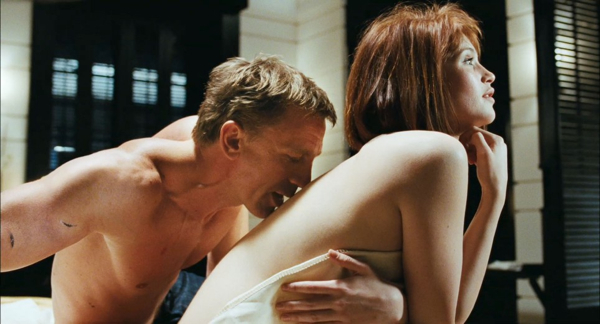Movie review by Greg Carlson
“Quantum of Solace” is several notches below “Casino Royale,” but Daniel Craig continues to demonstrate that his James Bond is arguably the best. Directed by Marc Forster, whose eclectic choices behind the camera can be hit or miss, “Quantum of Solace” manages a noteworthy pair of Bond statistics: it is the shortest movie in the series to date, running more than a half hour tighter than its predecessor, and it is also the first of the Bond films to pick up immediately where the previous story left off. Beyond those two facts, there is little to distinguish “Quantum of Solace,” which is encumbered by hellacious, disorienting editing during its many action sequences as well as an awful, thudding score by David Arnold.
While nowhere near the bottom of the heap in the Bond archive – it is handily better than any of the Brosnan and Dalton entries – “Quantum of Solace” won’t be placed near the top by many franchise fans either. Forster spends too much time staging action at the expense of the downtime needed to explore the revitalized Bond, who is still learning the ropes and figuring out the angles of the 00 license. It is still novel, if not fascinating, to see a Bond portrayal that suggests a rookie as opposed to a veteran, but one gets the feeling that by the next outing, that particular aspect of the storyline will be shelved.
The movie Bond’s voracious sexual appetite for exotic partners has been scrutinized by pop culture academics for years (recall the discussions of the post-HIV epidemic Bond in the reviews of an earlier decade’s “reboot”), but the agent’s persuasive way with the opposite sex has been a sacred cow, as certain as the sunrise. No rules demand that Bond have intercourse with every significant female whose path he crosses, and “Quantum of Solace” is particularly lean on eroticism. Bond’s relationship with fellow revenge-seeker Camille (Olga Kurylenko) is chaste, but the screenplay does squeeze in a dalliance with Gemma Arterton’s Strawberry Fields, whose fate is revealed in a clever visual nod to “Goldfinger.”
Considering the popularity of the “Bourne” series, one can easily understand why a Cold War relic like the Bond suite would brush the dust from itself in imitation. Some longtime followers will cringe at the latest Bond’s similarities to Bourne, but if the Craig era continues to explore a darker Bond of the “blunt instrument” variety described by Fleming (and Judi Dench’s M in “Casino Royale”), it makes sense to linger a bit when the man chokes the life out of an attacker. A less cartoonish Bond universe, which seems to be Craig’s cup of tea, beats the silly gadgetry and inane wordplay that some admirers cling to like a security blanket.
If one accepts the premise that there can be a Bond for every generation, then making the character a bit richer and deeper risks nothing; after all, if that tactic does not work, the series can find a new lead and start all over again (again). “Casino Royale,” in allowing Bond to develop feelings for Vesper Lynd (who is very much missed in “Quantum of Solace”), recalled “On Her Majesty’s Secret Service,” a cult favorite. In the new film, we are told that Bond acts out of grief, but the screenplay avoids any kind of psychological exploration of the operative’s motives. The inclusion of that sort of content could really shake up the rigid Bond universe.
